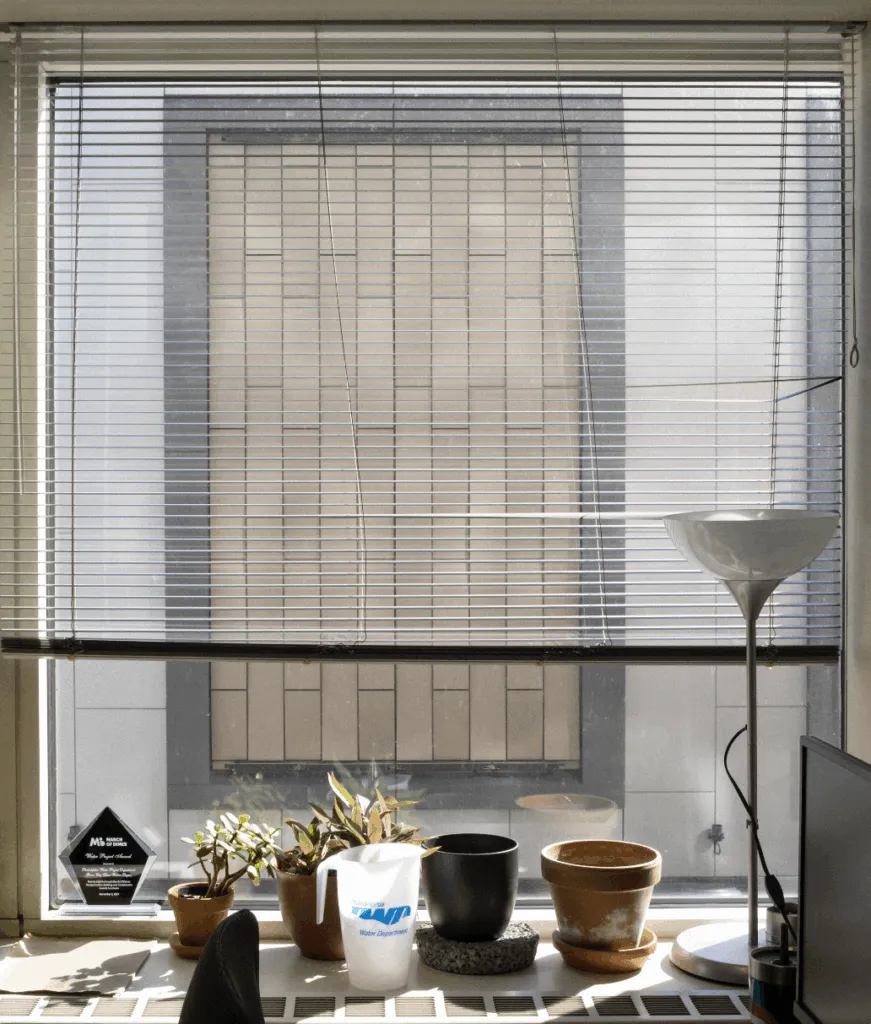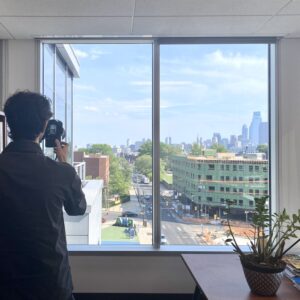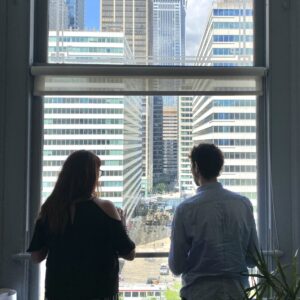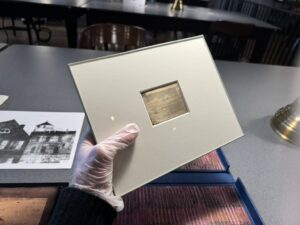What is a Civic View?

Artist Emilio Martínez Poppe’s Civic Views Highlights Philadelphia’s Municipal Workers and their Perspectives on the City.
How do we see our city and the people who keep it running? What do we take for granted and how might we experience Philadelphia differently if the curtain of city government was pulled back for us to look inside? Civic Views is a temporary public art project celebrating the city’s municipal employees and their diverse perspectives on Philadelphia through a poetic picturing of their office windows. On view beginning May 23 through Jun 11, 2025, the project takes up the City Hall Courtyard as a site to speak about the current state of the public sector. Mural Arts’ Curator of Public Practice, Jameson Paige, sat down to speak with artist Emilio Martínez Poppe about the origins of the project and how it’s come to be debuted in its current incarnation.
Jameson Paige (JP): Emilio, Civic Views is a project we’ve been working on for several years now that’s evolved quite a bit since we initially set out to produce it as a public artwork. One of the joys of tending to a project such as this for a long time is that you’re able to see it take shape slowly, accumulating and shedding elements, knowledge, and contexts as it progresses. The iteration we are about to present in May is quite different from our initial, more modest intentions. It’s grown to become a concentrated view of city government’s complexity, grafted together through photographs, interviews, and scaffolding. A lot of this is owed to your care and facility as an artist. Could you trace a timeline of the project through your eyes, marking some of its chapters along the way?
Emilio Martínez Poppe (EMP): It has been a long journey and one that I am lucky to have taken with you. Artists are fortunate when a curator becomes more of a collaborator than a facilitator in the development of a project. When you first invited me to expand Civic Views into a public artwork in 2022 it consisted solely of the photographic element, which has remained consistent throughout: photographs taken through the windows of Philadelphia’s service agencies printed to scale and hung to exact specifications that replicate the experience of looking out of each window.
Given the opportunity to grow the photo series, my initial idea consisted of pairing them with research on the architectural and political histories of the buildings we were visiting over the course of the project. This was reflected in my first formal proposal to mimic public information panels where one side would feature a photo and the reverse would include a collage of references that would situate the window’s view. By this point we had already started visiting some city department offices and added the interview component, a living historical counterpoint to the archival materials. Since then, it became clear that the interviews were the most compelling and urgent textual companion to the photographs. It was such a precious encounter with many folks who at times felt like their work does not get the recognition it deserves, lost in the abstraction of “the city” while still reconciling with the necessary cohesion it entails.
I feel so grateful to those who opened up to me and talked about the complexities of public sector work, the moments of pride, change, and contradiction. At the same time we kept hitting roadblocks in our installation strategies which consequently led to my idea of using scaffolding as a formal register of the changes taking place in the city and those felt over the careers of the civil servants we were interviewing. Throughout this process I feel that I have been changed by the project as much as it has changed in form. The way I think about my own work as a city employee has taken on a new meaning especially in light of the new administration’s assault on the public sector.

JP: One aspect that can never be planned for—especially with a timeline of a few years—is what kind of sociopolitical context will the work be welcomed into. Since Trump’s inauguration, civil servants’ positions across the country have been at risk for termination, signifying a devastating and irreparable gutting of so many departments at the federal level. Though Civic Views specifically highlights Philadelphia municipal employees, the kinship across the public sector is palpable and the solidarity we’ve encountered is incredibly inspiring. One of the project’s origin points for you was to map how the people of city government experience the changes of Philadelphia. The project certainly still captures this, but now it also maps how government itself changes, from the municipal to the federal level.
EMP: This is absolutely true, and how these epochal changes are expressed at an intimate scale. When I was taking preliminary steps to develop the project in 2021, the Trump administration had already laid the groundwork for the systematic mass layoffs at the federal level we have seen over the past couple of months by the so-called Department of Government Efficiency (DOGE). Since inauguration day, nearly 300,000 federal employees across the country have been laid off from the United States Agency for International Development, the Consumer Financial Protection Bureau, the Department of Education, and many more. We have yet to feel the full force of this assault on labor and public services but we are already seeing the threat of pulling federal funding affecting public wellbeing, safety, and sense of community all under the auspices of eliminating “inefficiency.”
The notion that civil servants are inefficient has come up in the interviews as a dynamic that city employees constantly wrestle with. Now we are seeing this very dynamic weaponized against the public sector as a whole. Under this new regime, “efficiency,” is the systematic and total privatization of essential social services millions rely on. I believe that to be a civil servant is to stand in resistance to these terms as they have been set by the rise of American authoritarianism. It has been inspiring to witness the Federal Unionist Network in coalition with federal, state, and municipal labor unions coming together to resist the layoffs. As Lee Saunders, the President of the American Federation of State, County and Municipal Employees, said “we deserve a government that looks after the interests of working people, not just the profits of billionaires.”

JP: I think a lot of these ideas will come to life through the programming we have planned. Building off Civic Views’ main anchors, these public programs will focus on the image, form, and labor of the city. Though your project has a relatively minimal and accessible approach, it retains the capacity for so much depth of conversation. Photos, text, scaffolding, and site—a simple equation that’s nevertheless filled with possibility. It’s one of my favorite things about this project, that it’s able to be so approachable and yet earnestly opens itself to the world. I’d love for you to speak a bit more about arriving at this aesthetic configuration. Of course there’s art historical references to note, but I think the shape of the project has also been responsive to the people we’ve encountered as well.
EMP: Absolutely, the project is interdisciplinary in form and influence, drawing from the history of photography, legacies of urban planning in Philadelphia, and the personal stories of city employees I interviewed. The inspiration for Civic Views first came about during my time as a city planning student while I reflected on the positions we were being trained for and that I would later take on as a city employee myself—both symbolically and literally. For example in one of my courses we were provided an illuminating framing through which to consider the site of the African American Museum in Philadelphia that sits in a sea of parking lots surrounded by the former Philadelphia Police Department headquarters at the Roundhouse and federal agencies including the FBI, ICE, and DOC. Consideration of our physical positions reveal relations of power and hopefully, openings to unravel their contradictions. I held onto this awareness when I learned that the oldest surviving photograph in the country was shot through a window by a civil servant of Philadelphia’s US mint in 1839, at a time when the nation was undergoing massive transformations in the way citizenship, property, humanity, and solidarity were understood. We are in one of those times today.
While our institutions may seem intractable they are vulnerable to progressive and regressive intervention as we are seeing at the federal level today. This reality led me to the scaffolding as form and support for the window views and testimonies of city employees. I had already been paying close attention to their rising presence across Philadelphia as construction is seen across the city and discussed at length across my interviews. As I consider the capacities of civil servants to transform the city they tend to each day, I hope to reinforce that our “image of the city” is always under construction. While the windows evoke positions of power, the scaffolding armature they are mounted on is a reminder that the civic infrastructure that hosts them is mutable and dynamic—it was created by humans and therefore can be changed by them.
JP: It may seem backwards to return to the beginning, but as a final question I want to consider how Joseph Saxton’s 1839 daguerreotype has informed this project. I know it was one of the first inspirations for Civic Views and has remained potent materially and conceptually throughout its trajectory. I’ve also noticed that it’s something we’ve come back to often the closer we get to the opening of Civic Views. What has Saxton’s image meant to you across the life of this project? How has its meaning changed?

EMP: The project began while I was studying the photographic history of Philadelphia, discovering that the oldest surviving daguerreotype I mentioned earlier was taken in the US by Joseph Saxton in 1839. Saxton was working in the engraving department of the US mint where he was perfecting medal ruling technology used for reproducing reliefs on paper such as the documentation of medals and coins. In the weeks after the global announcement of the groundbreaking daguerreotype technology, Saxton found himself surrounded by the materials he would need to take his historic photograph. He cobbled together a matchbox housing, reading glass lens, iodine exposure agent, and a strip of polished copper from which coins were cut and positioned his makeshift camera out of his office window to capture the upper floors of the first Philadelphia Central High School and a state arsenal. It was only twenty years later that the school and arsenal were demolished with the Mint’s demolition following close behind. Both sites became highly desired for urban investment as planning for City Hall’s relocation to Centre Square began. The photograph remains as the sole visual point of entry into Saxton’s position. Today the Widener Building occupies the former site of the Mint where the District Attorney’s office is located and I was able to visit, creating what felt like a full circle in this project.
By revisiting Saxton’s perspective in the legislative hub of the city through the Civic Views photographs, I hope to draw attention to the conditions that shape our notions of what a city is, how it should look, and who it is for. While these definitions vary across positions in city government, it is clear from my conversations with civil servants there is a shared sense of responsibility in empowering more people to participate in the meaning-making of the city. How do we find new ways to see, even when it might seem impossible to do so? Like the public sector work and infrastructure I am documenting, I believe public art shares this responsibility and can offer new ways to understand our capacities to transform the city, and so ourselves, together.
Emilio Martínez Poppe is an artist who is concerned with the right to the city and the struggle of public memory. Through a social and research-led practice spanning photography, sculpture, text, and installations, he explores the spatial mechanisms and ideological conditions that reproduce state and capital infrastructures. Martínez Poppe has previously exhibited work at Petrine, Paris; the Queens Museum, New York; Tiger Strikes Asteroid, Philadelphia; and de Brakke Grond, Amsterdam. Martínez Poppe earned an MFA and MCP from the University of Pennsylvania, a BFA from The Cooper Union School of Art, was a studio fellow in the Whitney Independent Study Program, and a member of BFAMFAPhD. He is a member of the Pinko collective and a Visiting Assistant Professor in the Graduate Communications Design department at Pratt Institute. His work has been supported through artist residencies at Abrons Arts Center, Pratt Institute, NEW INC, SOMA Mexico, and through grants/fellowships from The Laundromat Project, The Sachs Program for Arts Innovation, PennPraxis, and the UPenn Graduate and Professional Student Assembly. Martínez Poppe received the Charles Addams Memorial Prize and the Paul Davidoff Award from the University of Pennsylvania.
Jameson Paige is a curator and writer based in Philadelphia. He is interested in contemporary art’s engagement with spatial politics, history, negotiations of identity, and problems of representation. He has held previous positions as Curatorial Fellow at the Institute for Curatorial Research and Practice, and as Assistant Curator for the Envisioning Justice Initiative in Chicago. He is currently the Curator of Public Practice at Mural Arts Philadelphia and teaches in the School of Art, Design History and Theory at Parsons School of Design. Paige has presented his work nationally at Bryn Mawr College, the College Art Association’s Annual Conference, Northwestern University, Minneapolis College of Art and Design, and the Maryland Institute College of Art, among others. Recent exhibitions have been presented at Fjord, Philadelphia; as part of BIENALSUR at la Universidad de las Américas Puebla, MX; the Charlotte Street Foundation, Kansas City; and the Sullivan Galleries, Chicago. His writing has appeared in Hyperallergic, Cultured, Burnaway, Public Parking, The SEEN, Contango, and Newcity.
Learn more about this project here.
